Entrepreneurship: Small Business Management, Ventures and Analysis
VerifiedAdded on 2023/01/10
|18
|5019
|95
Report
AI Summary
This report provides a comprehensive analysis of entrepreneurship and small business management. It explores various entrepreneurial ventures, their typologies, similarities, and differences, emphasizing the economic impact of small and medium-sized enterprises (SMEs). The report interprets data related to SMEs, highlighting their importance in job creation and economic contribution. It also examines the characteristic traits and skills of entrepreneurs, including aspects of entrepreneurial personality and motivational drivers. Furthermore, the report delves into the background and experience necessary for successful entrepreneurship, offering a critical evaluation of how experience shapes entrepreneurial success. The study concludes by underscoring the significance of fostering a supportive environment for entrepreneurship and small business growth, with insights applicable to both public and private sectors. Desklib offers more resources like this to aid student learning.

Entrepreneurship and
Small Business
Management
Small Business
Management
Paraphrase This Document
Need a fresh take? Get an instant paraphrase of this document with our AI Paraphraser

Contents
INTRODUCTION...........................................................................................................................................3
TASK 1..........................................................................................................................................................3
Entrepreneurial ventures and interrelation to typologies.......................................................................3
Similarities as well as differences between ventures of entrepreneurial................................................5
Entrepreneurial ventures for demonstrating entrepreneurship..............................................................6
Growth, scope together with development............................................................................................7
TASK 2..........................................................................................................................................................7
Data interpretation..................................................................................................................................7
Importance of small businesses...............................................................................................................8
Differentiation among small, medium.....................................................................................................9
Examination of small businesses.............................................................................................................9
TASK 3........................................................................................................................................................10
Characteristic traits together with skills of entrepreneurs....................................................................10
Aspects of entrepreneurial personality.................................................................................................10
Different lines of arguments..................................................................................................................12
Analysis of characteristic traits and motivational drivers......................................................................12
TASK 4........................................................................................................................................................12
Background and experience..................................................................................................................12
Experience and background..................................................................................................................13
Critical evaluation of experience and background.................................................................................14
CONCLUSION.............................................................................................................................................14
REFERENCES..............................................................................................................................................16
INTRODUCTION...........................................................................................................................................3
TASK 1..........................................................................................................................................................3
Entrepreneurial ventures and interrelation to typologies.......................................................................3
Similarities as well as differences between ventures of entrepreneurial................................................5
Entrepreneurial ventures for demonstrating entrepreneurship..............................................................6
Growth, scope together with development............................................................................................7
TASK 2..........................................................................................................................................................7
Data interpretation..................................................................................................................................7
Importance of small businesses...............................................................................................................8
Differentiation among small, medium.....................................................................................................9
Examination of small businesses.............................................................................................................9
TASK 3........................................................................................................................................................10
Characteristic traits together with skills of entrepreneurs....................................................................10
Aspects of entrepreneurial personality.................................................................................................10
Different lines of arguments..................................................................................................................12
Analysis of characteristic traits and motivational drivers......................................................................12
TASK 4........................................................................................................................................................12
Background and experience..................................................................................................................12
Experience and background..................................................................................................................13
Critical evaluation of experience and background.................................................................................14
CONCLUSION.............................................................................................................................................14
REFERENCES..............................................................................................................................................16
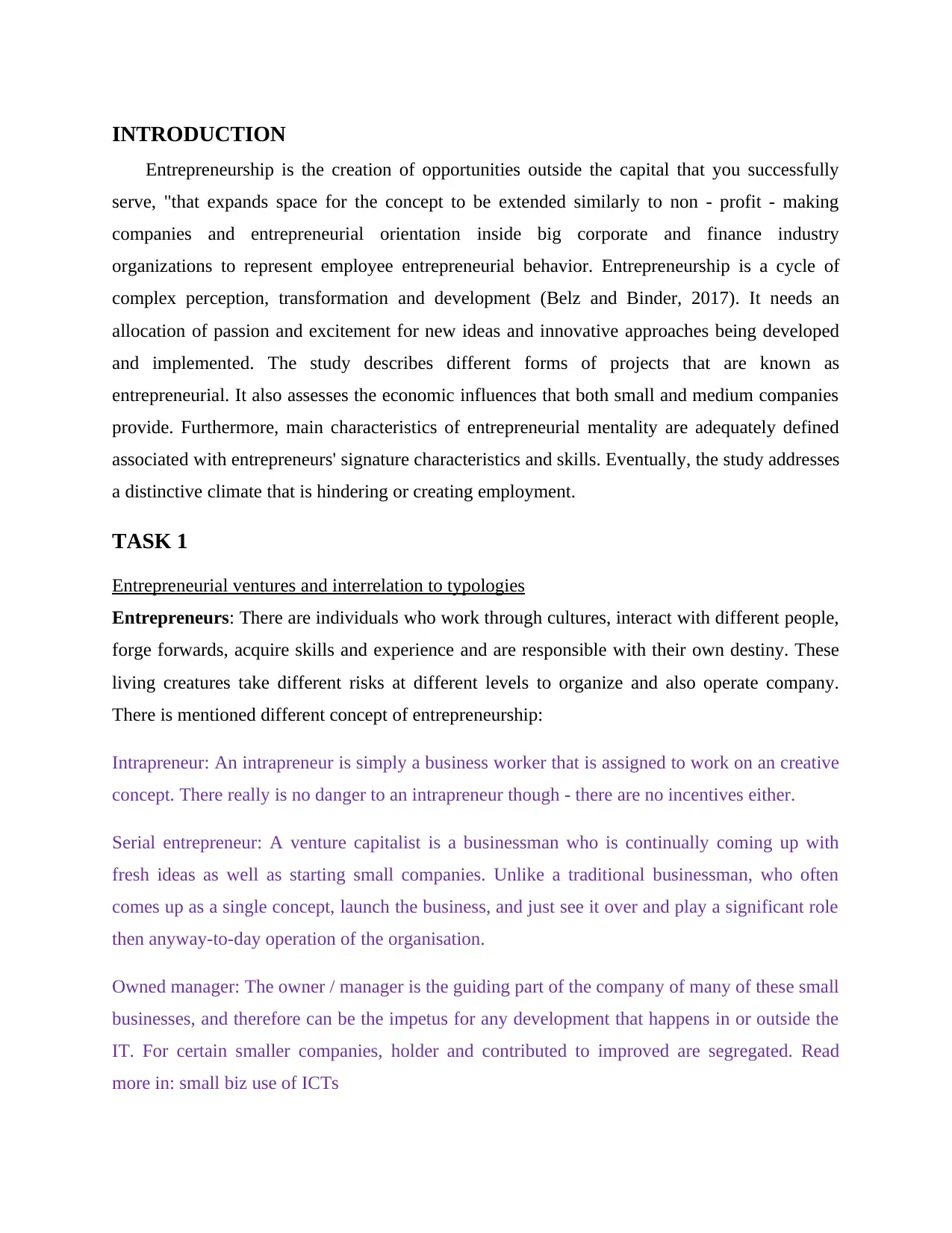
INTRODUCTION
Entrepreneurship is the creation of opportunities outside the capital that you successfully
serve, "that expands space for the concept to be extended similarly to non - profit - making
companies and entrepreneurial orientation inside big corporate and finance industry
organizations to represent employee entrepreneurial behavior. Entrepreneurship is a cycle of
complex perception, transformation and development (Belz and Binder, 2017). It needs an
allocation of passion and excitement for new ideas and innovative approaches being developed
and implemented. The study describes different forms of projects that are known as
entrepreneurial. It also assesses the economic influences that both small and medium companies
provide. Furthermore, main characteristics of entrepreneurial mentality are adequately defined
associated with entrepreneurs' signature characteristics and skills. Eventually, the study addresses
a distinctive climate that is hindering or creating employment.
TASK 1
Entrepreneurial ventures and interrelation to typologies
Entrepreneurs: There are individuals who work through cultures, interact with different people,
forge forwards, acquire skills and experience and are responsible with their own destiny. These
living creatures take different risks at different levels to organize and also operate company.
There is mentioned different concept of entrepreneurship:
Intrapreneur: An intrapreneur is simply a business worker that is assigned to work on an creative
concept. There really is no danger to an intrapreneur though - there are no incentives either.
Serial entrepreneur: A venture capitalist is a businessman who is continually coming up with
fresh ideas as well as starting small companies. Unlike a traditional businessman, who often
comes up as a single concept, launch the business, and just see it over and play a significant role
then anyway-to-day operation of the organisation.
Owned manager: The owner / manager is the guiding part of the company of many of these small
businesses, and therefore can be the impetus for any development that happens in or outside the
IT. For certain smaller companies, holder and contributed to improved are segregated. Read
more in: small biz use of ICTs
Entrepreneurship is the creation of opportunities outside the capital that you successfully
serve, "that expands space for the concept to be extended similarly to non - profit - making
companies and entrepreneurial orientation inside big corporate and finance industry
organizations to represent employee entrepreneurial behavior. Entrepreneurship is a cycle of
complex perception, transformation and development (Belz and Binder, 2017). It needs an
allocation of passion and excitement for new ideas and innovative approaches being developed
and implemented. The study describes different forms of projects that are known as
entrepreneurial. It also assesses the economic influences that both small and medium companies
provide. Furthermore, main characteristics of entrepreneurial mentality are adequately defined
associated with entrepreneurs' signature characteristics and skills. Eventually, the study addresses
a distinctive climate that is hindering or creating employment.
TASK 1
Entrepreneurial ventures and interrelation to typologies
Entrepreneurs: There are individuals who work through cultures, interact with different people,
forge forwards, acquire skills and experience and are responsible with their own destiny. These
living creatures take different risks at different levels to organize and also operate company.
There is mentioned different concept of entrepreneurship:
Intrapreneur: An intrapreneur is simply a business worker that is assigned to work on an creative
concept. There really is no danger to an intrapreneur though - there are no incentives either.
Serial entrepreneur: A venture capitalist is a businessman who is continually coming up with
fresh ideas as well as starting small companies. Unlike a traditional businessman, who often
comes up as a single concept, launch the business, and just see it over and play a significant role
then anyway-to-day operation of the organisation.
Owned manager: The owner / manager is the guiding part of the company of many of these small
businesses, and therefore can be the impetus for any development that happens in or outside the
IT. For certain smaller companies, holder and contributed to improved are segregated. Read
more in: small biz use of ICTs
⊘ This is a preview!⊘
Do you want full access?
Subscribe today to unlock all pages.

Trusted by 1+ million students worldwide
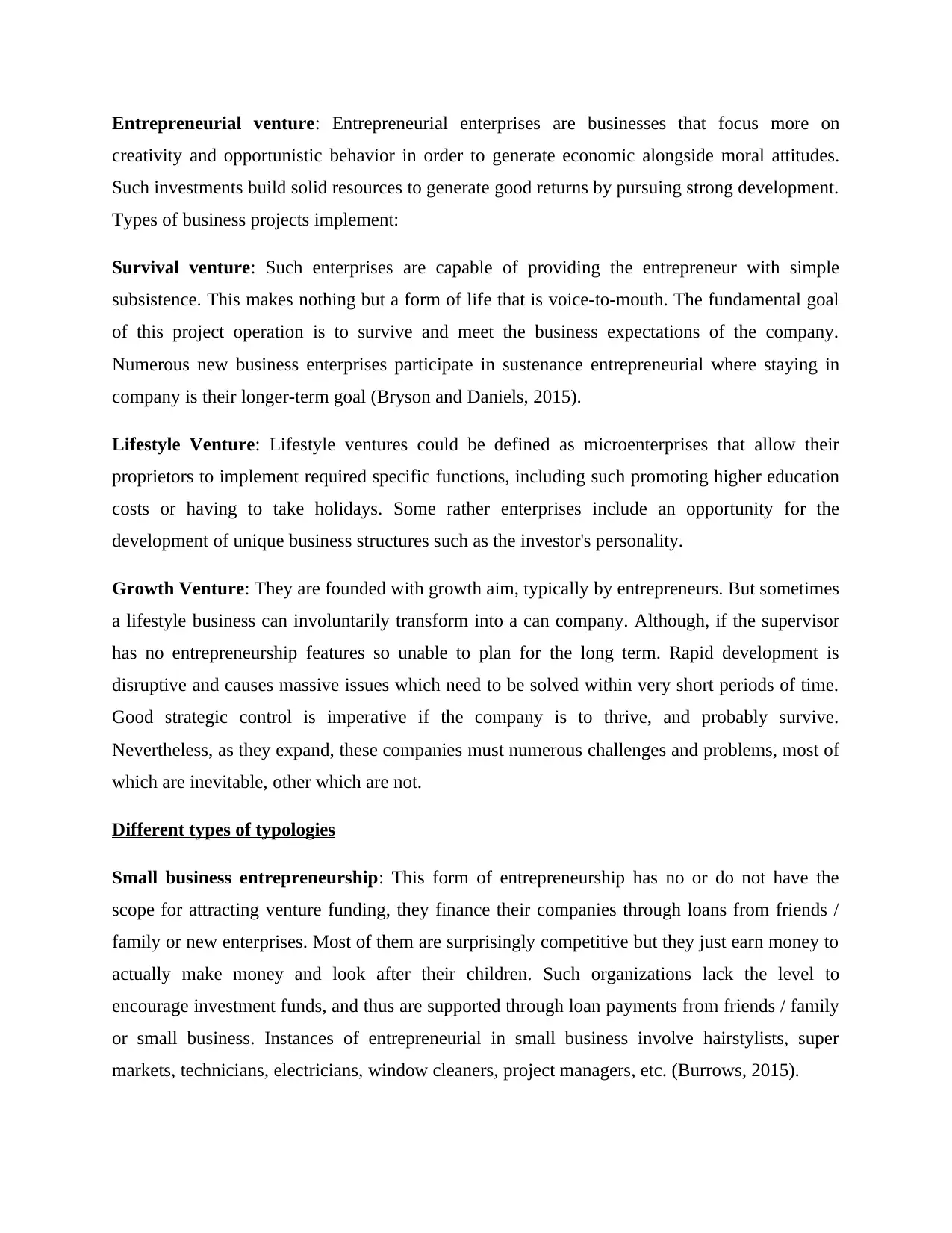
Entrepreneurial venture: Entrepreneurial enterprises are businesses that focus more on
creativity and opportunistic behavior in order to generate economic alongside moral attitudes.
Such investments build solid resources to generate good returns by pursuing strong development.
Types of business projects implement:
Survival venture: Such enterprises are capable of providing the entrepreneur with simple
subsistence. This makes nothing but a form of life that is voice-to-mouth. The fundamental goal
of this project operation is to survive and meet the business expectations of the company.
Numerous new business enterprises participate in sustenance entrepreneurial where staying in
company is their longer-term goal (Bryson and Daniels, 2015).
Lifestyle Venture: Lifestyle ventures could be defined as microenterprises that allow their
proprietors to implement required specific functions, including such promoting higher education
costs or having to take holidays. Some rather enterprises include an opportunity for the
development of unique business structures such as the investor's personality.
Growth Venture: They are founded with growth aim, typically by entrepreneurs. But sometimes
a lifestyle business can involuntarily transform into a can company. Although, if the supervisor
has no entrepreneurship features so unable to plan for the long term. Rapid development is
disruptive and causes massive issues which need to be solved within very short periods of time.
Good strategic control is imperative if the company is to thrive, and probably survive.
Nevertheless, as they expand, these companies must numerous challenges and problems, most of
which are inevitable, other which are not.
Different types of typologies
Small business entrepreneurship: This form of entrepreneurship has no or do not have the
scope for attracting venture funding, they finance their companies through loans from friends /
family or new enterprises. Most of them are surprisingly competitive but they just earn money to
actually make money and look after their children. Such organizations lack the level to
encourage investment funds, and thus are supported through loan payments from friends / family
or small business. Instances of entrepreneurial in small business involve hairstylists, super
markets, technicians, electricians, window cleaners, project managers, etc. (Burrows, 2015).
creativity and opportunistic behavior in order to generate economic alongside moral attitudes.
Such investments build solid resources to generate good returns by pursuing strong development.
Types of business projects implement:
Survival venture: Such enterprises are capable of providing the entrepreneur with simple
subsistence. This makes nothing but a form of life that is voice-to-mouth. The fundamental goal
of this project operation is to survive and meet the business expectations of the company.
Numerous new business enterprises participate in sustenance entrepreneurial where staying in
company is their longer-term goal (Bryson and Daniels, 2015).
Lifestyle Venture: Lifestyle ventures could be defined as microenterprises that allow their
proprietors to implement required specific functions, including such promoting higher education
costs or having to take holidays. Some rather enterprises include an opportunity for the
development of unique business structures such as the investor's personality.
Growth Venture: They are founded with growth aim, typically by entrepreneurs. But sometimes
a lifestyle business can involuntarily transform into a can company. Although, if the supervisor
has no entrepreneurship features so unable to plan for the long term. Rapid development is
disruptive and causes massive issues which need to be solved within very short periods of time.
Good strategic control is imperative if the company is to thrive, and probably survive.
Nevertheless, as they expand, these companies must numerous challenges and problems, most of
which are inevitable, other which are not.
Different types of typologies
Small business entrepreneurship: This form of entrepreneurship has no or do not have the
scope for attracting venture funding, they finance their companies through loans from friends /
family or new enterprises. Most of them are surprisingly competitive but they just earn money to
actually make money and look after their children. Such organizations lack the level to
encourage investment funds, and thus are supported through loan payments from friends / family
or small business. Instances of entrepreneurial in small business involve hairstylists, super
markets, technicians, electricians, window cleaners, project managers, etc. (Burrows, 2015).
Paraphrase This Document
Need a fresh take? Get an instant paraphrase of this document with our AI Paraphraser
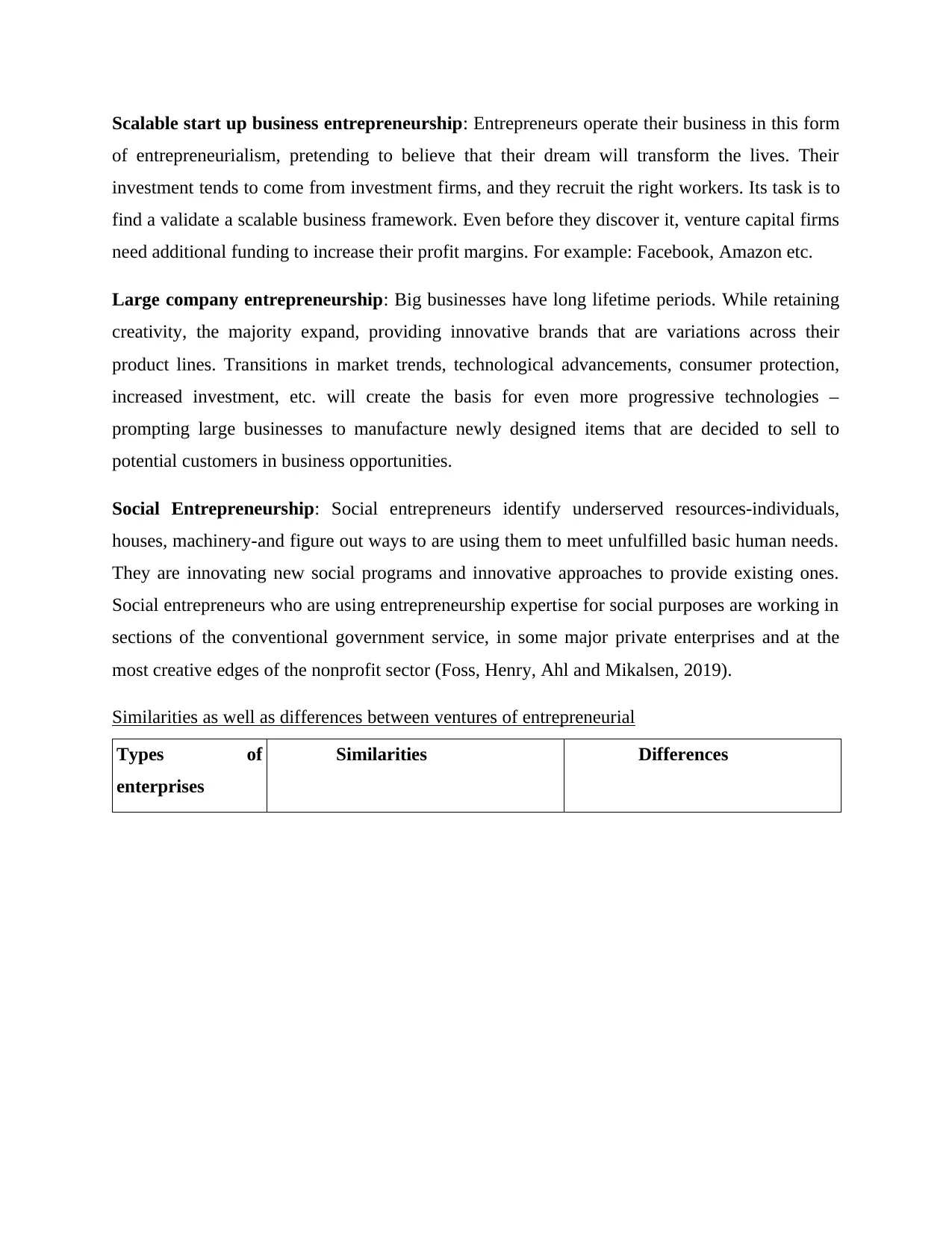
Scalable start up business entrepreneurship: Entrepreneurs operate their business in this form
of entrepreneurialism, pretending to believe that their dream will transform the lives. Their
investment tends to come from investment firms, and they recruit the right workers. Its task is to
find a validate a scalable business framework. Even before they discover it, venture capital firms
need additional funding to increase their profit margins. For example: Facebook, Amazon etc.
Large company entrepreneurship: Big businesses have long lifetime periods. While retaining
creativity, the majority expand, providing innovative brands that are variations across their
product lines. Transitions in market trends, technological advancements, consumer protection,
increased investment, etc. will create the basis for even more progressive technologies –
prompting large businesses to manufacture newly designed items that are decided to sell to
potential customers in business opportunities.
Social Entrepreneurship: Social entrepreneurs identify underserved resources-individuals,
houses, machinery-and figure out ways to are using them to meet unfulfilled basic human needs.
They are innovating new social programs and innovative approaches to provide existing ones.
Social entrepreneurs who are using entrepreneurship expertise for social purposes are working in
sections of the conventional government service, in some major private enterprises and at the
most creative edges of the nonprofit sector (Foss, Henry, Ahl and Mikalsen, 2019).
Similarities as well as differences between ventures of entrepreneurial
Types of
enterprises
Similarities Differences
of entrepreneurialism, pretending to believe that their dream will transform the lives. Their
investment tends to come from investment firms, and they recruit the right workers. Its task is to
find a validate a scalable business framework. Even before they discover it, venture capital firms
need additional funding to increase their profit margins. For example: Facebook, Amazon etc.
Large company entrepreneurship: Big businesses have long lifetime periods. While retaining
creativity, the majority expand, providing innovative brands that are variations across their
product lines. Transitions in market trends, technological advancements, consumer protection,
increased investment, etc. will create the basis for even more progressive technologies –
prompting large businesses to manufacture newly designed items that are decided to sell to
potential customers in business opportunities.
Social Entrepreneurship: Social entrepreneurs identify underserved resources-individuals,
houses, machinery-and figure out ways to are using them to meet unfulfilled basic human needs.
They are innovating new social programs and innovative approaches to provide existing ones.
Social entrepreneurs who are using entrepreneurship expertise for social purposes are working in
sections of the conventional government service, in some major private enterprises and at the
most creative edges of the nonprofit sector (Foss, Henry, Ahl and Mikalsen, 2019).
Similarities as well as differences between ventures of entrepreneurial
Types of
enterprises
Similarities Differences
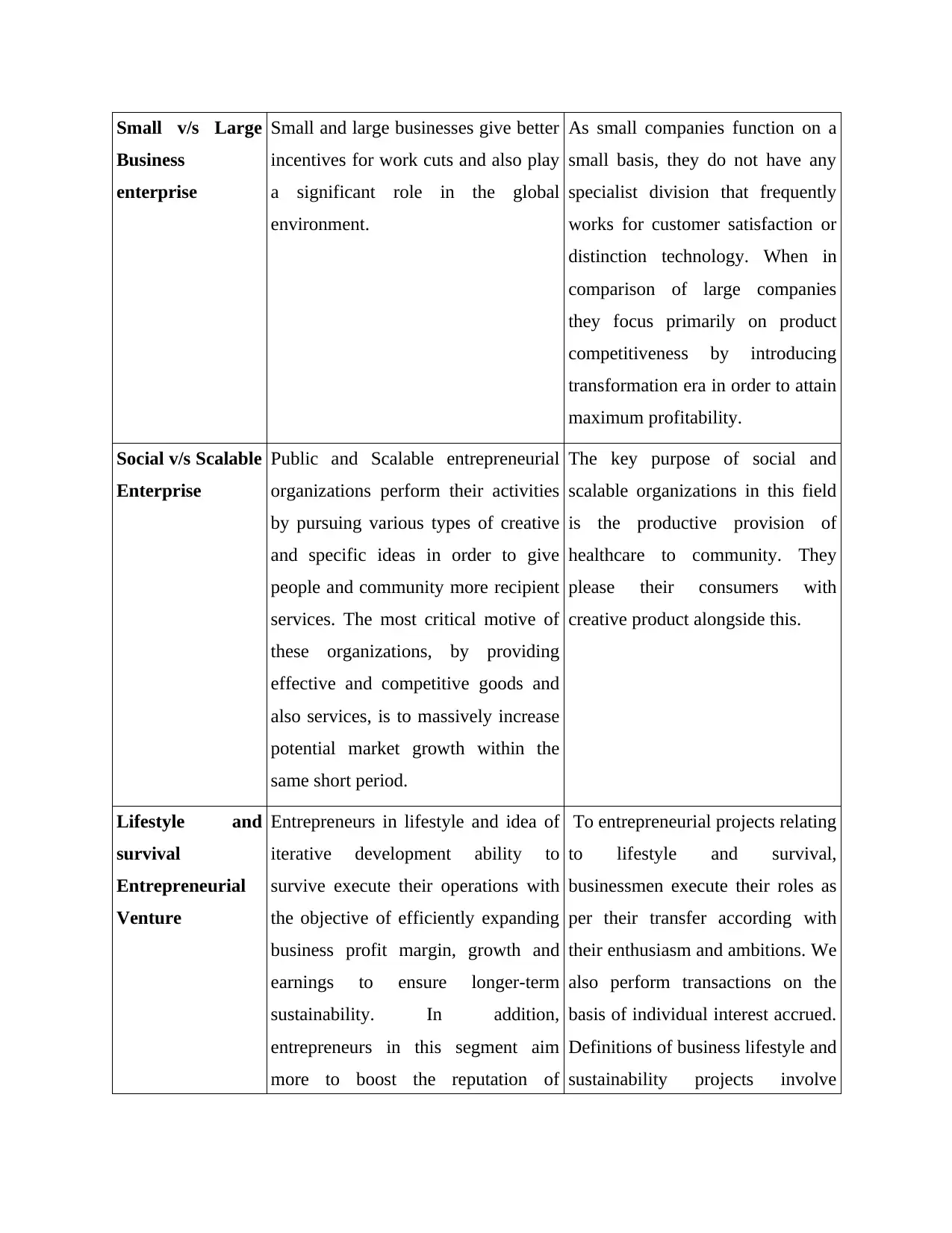
Small v/s Large
Business
enterprise
Small and large businesses give better
incentives for work cuts and also play
a significant role in the global
environment.
As small companies function on a
small basis, they do not have any
specialist division that frequently
works for customer satisfaction or
distinction technology. When in
comparison of large companies
they focus primarily on product
competitiveness by introducing
transformation era in order to attain
maximum profitability.
Social v/s Scalable
Enterprise
Public and Scalable entrepreneurial
organizations perform their activities
by pursuing various types of creative
and specific ideas in order to give
people and community more recipient
services. The most critical motive of
these organizations, by providing
effective and competitive goods and
also services, is to massively increase
potential market growth within the
same short period.
The key purpose of social and
scalable organizations in this field
is the productive provision of
healthcare to community. They
please their consumers with
creative product alongside this.
Lifestyle and
survival
Entrepreneurial
Venture
Entrepreneurs in lifestyle and idea of
iterative development ability to
survive execute their operations with
the objective of efficiently expanding
business profit margin, growth and
earnings to ensure longer-term
sustainability. In addition,
entrepreneurs in this segment aim
more to boost the reputation of
To entrepreneurial projects relating
to lifestyle and survival,
businessmen execute their roles as
per their transfer according with
their enthusiasm and ambitions. We
also perform transactions on the
basis of individual interest accrued.
Definitions of business lifestyle and
sustainability projects involve
Business
enterprise
Small and large businesses give better
incentives for work cuts and also play
a significant role in the global
environment.
As small companies function on a
small basis, they do not have any
specialist division that frequently
works for customer satisfaction or
distinction technology. When in
comparison of large companies
they focus primarily on product
competitiveness by introducing
transformation era in order to attain
maximum profitability.
Social v/s Scalable
Enterprise
Public and Scalable entrepreneurial
organizations perform their activities
by pursuing various types of creative
and specific ideas in order to give
people and community more recipient
services. The most critical motive of
these organizations, by providing
effective and competitive goods and
also services, is to massively increase
potential market growth within the
same short period.
The key purpose of social and
scalable organizations in this field
is the productive provision of
healthcare to community. They
please their consumers with
creative product alongside this.
Lifestyle and
survival
Entrepreneurial
Venture
Entrepreneurs in lifestyle and idea of
iterative development ability to
survive execute their operations with
the objective of efficiently expanding
business profit margin, growth and
earnings to ensure longer-term
sustainability. In addition,
entrepreneurs in this segment aim
more to boost the reputation of
To entrepreneurial projects relating
to lifestyle and survival,
businessmen execute their roles as
per their transfer according with
their enthusiasm and ambitions. We
also perform transactions on the
basis of individual interest accrued.
Definitions of business lifestyle and
sustainability projects involve
⊘ This is a preview!⊘
Do you want full access?
Subscribe today to unlock all pages.

Trusted by 1+ million students worldwide
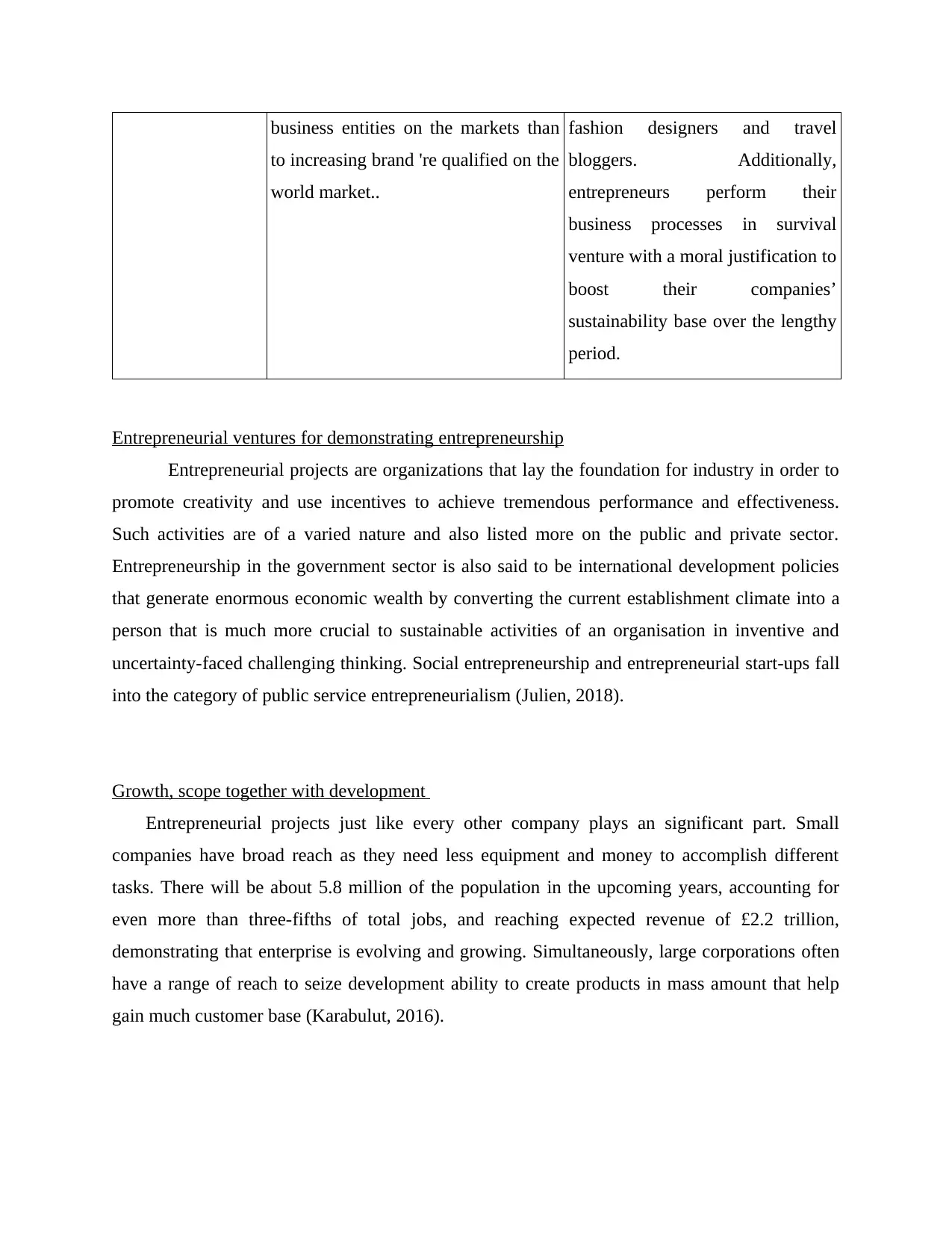
business entities on the markets than
to increasing brand 're qualified on the
world market..
fashion designers and travel
bloggers. Additionally,
entrepreneurs perform their
business processes in survival
venture with a moral justification to
boost their companies’
sustainability base over the lengthy
period.
Entrepreneurial ventures for demonstrating entrepreneurship
Entrepreneurial projects are organizations that lay the foundation for industry in order to
promote creativity and use incentives to achieve tremendous performance and effectiveness.
Such activities are of a varied nature and also listed more on the public and private sector.
Entrepreneurship in the government sector is also said to be international development policies
that generate enormous economic wealth by converting the current establishment climate into a
person that is much more crucial to sustainable activities of an organisation in inventive and
uncertainty-faced challenging thinking. Social entrepreneurship and entrepreneurial start-ups fall
into the category of public service entrepreneurialism (Julien, 2018).
Growth, scope together with development
Entrepreneurial projects just like every other company plays an significant part. Small
companies have broad reach as they need less equipment and money to accomplish different
tasks. There will be about 5.8 million of the population in the upcoming years, accounting for
even more than three-fifths of total jobs, and reaching expected revenue of £2.2 trillion,
demonstrating that enterprise is evolving and growing. Simultaneously, large corporations often
have a range of reach to seize development ability to create products in mass amount that help
gain much customer base (Karabulut, 2016).
to increasing brand 're qualified on the
world market..
fashion designers and travel
bloggers. Additionally,
entrepreneurs perform their
business processes in survival
venture with a moral justification to
boost their companies’
sustainability base over the lengthy
period.
Entrepreneurial ventures for demonstrating entrepreneurship
Entrepreneurial projects are organizations that lay the foundation for industry in order to
promote creativity and use incentives to achieve tremendous performance and effectiveness.
Such activities are of a varied nature and also listed more on the public and private sector.
Entrepreneurship in the government sector is also said to be international development policies
that generate enormous economic wealth by converting the current establishment climate into a
person that is much more crucial to sustainable activities of an organisation in inventive and
uncertainty-faced challenging thinking. Social entrepreneurship and entrepreneurial start-ups fall
into the category of public service entrepreneurialism (Julien, 2018).
Growth, scope together with development
Entrepreneurial projects just like every other company plays an significant part. Small
companies have broad reach as they need less equipment and money to accomplish different
tasks. There will be about 5.8 million of the population in the upcoming years, accounting for
even more than three-fifths of total jobs, and reaching expected revenue of £2.2 trillion,
demonstrating that enterprise is evolving and growing. Simultaneously, large corporations often
have a range of reach to seize development ability to create products in mass amount that help
gain much customer base (Karabulut, 2016).
Paraphrase This Document
Need a fresh take? Get an instant paraphrase of this document with our AI Paraphraser
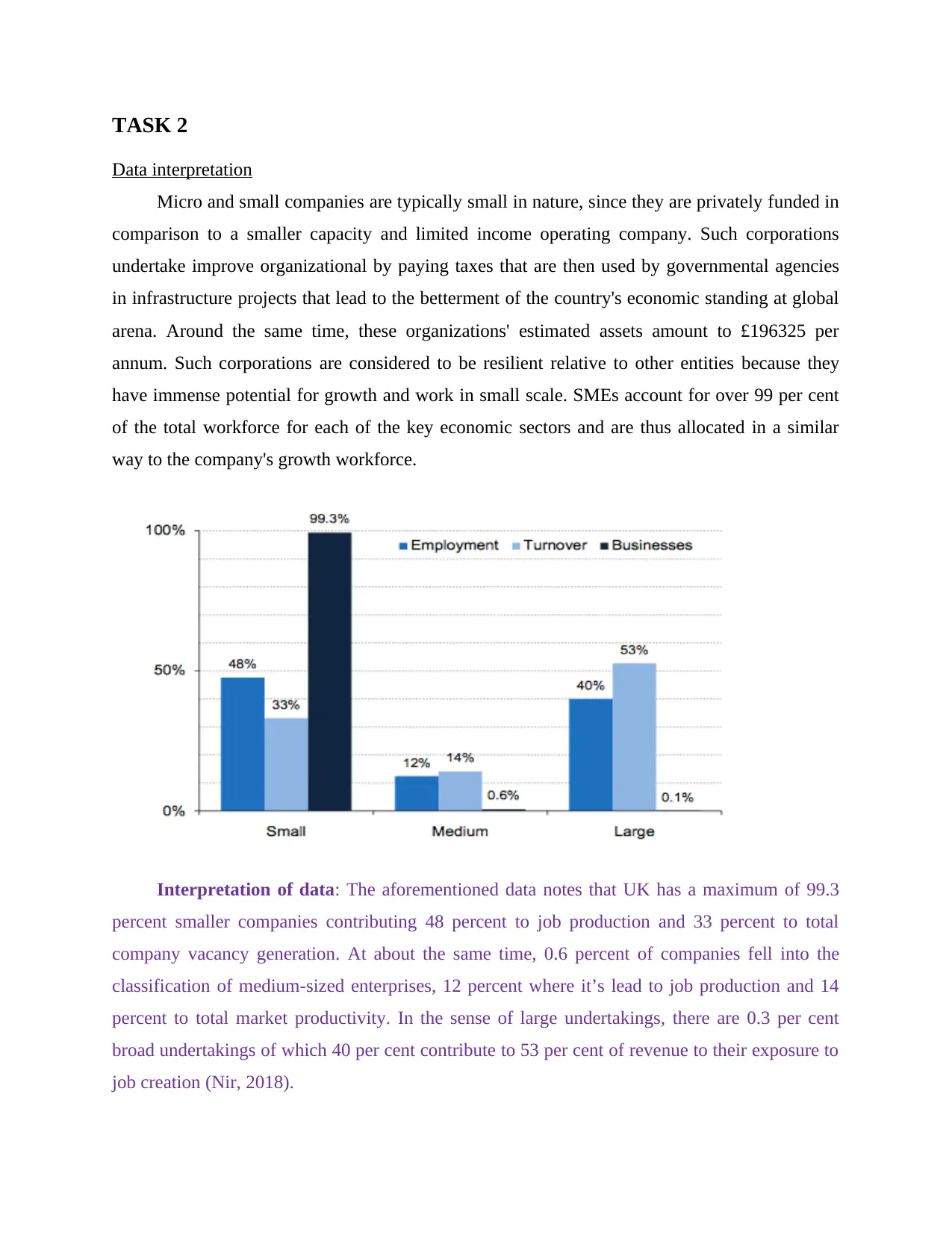
TASK 2
Data interpretation
Micro and small companies are typically small in nature, since they are privately funded in
comparison to a smaller capacity and limited income operating company. Such corporations
undertake improve organizational by paying taxes that are then used by governmental agencies
in infrastructure projects that lead to the betterment of the country's economic standing at global
arena. Around the same time, these organizations' estimated assets amount to £196325 per
annum. Such corporations are considered to be resilient relative to other entities because they
have immense potential for growth and work in small scale. SMEs account for over 99 per cent
of the total workforce for each of the key economic sectors and are thus allocated in a similar
way to the company's growth workforce.
Interpretation of data: The aforementioned data notes that UK has a maximum of 99.3
percent smaller companies contributing 48 percent to job production and 33 percent to total
company vacancy generation. At about the same time, 0.6 percent of companies fell into the
classification of medium-sized enterprises, 12 percent where it’s lead to job production and 14
percent to total market productivity. In the sense of large undertakings, there are 0.3 per cent
broad undertakings of which 40 per cent contribute to 53 per cent of revenue to their exposure to
job creation (Nir, 2018).
Data interpretation
Micro and small companies are typically small in nature, since they are privately funded in
comparison to a smaller capacity and limited income operating company. Such corporations
undertake improve organizational by paying taxes that are then used by governmental agencies
in infrastructure projects that lead to the betterment of the country's economic standing at global
arena. Around the same time, these organizations' estimated assets amount to £196325 per
annum. Such corporations are considered to be resilient relative to other entities because they
have immense potential for growth and work in small scale. SMEs account for over 99 per cent
of the total workforce for each of the key economic sectors and are thus allocated in a similar
way to the company's growth workforce.
Interpretation of data: The aforementioned data notes that UK has a maximum of 99.3
percent smaller companies contributing 48 percent to job production and 33 percent to total
company vacancy generation. At about the same time, 0.6 percent of companies fell into the
classification of medium-sized enterprises, 12 percent where it’s lead to job production and 14
percent to total market productivity. In the sense of large undertakings, there are 0.3 per cent
broad undertakings of which 40 per cent contribute to 53 per cent of revenue to their exposure to
job creation (Nir, 2018).
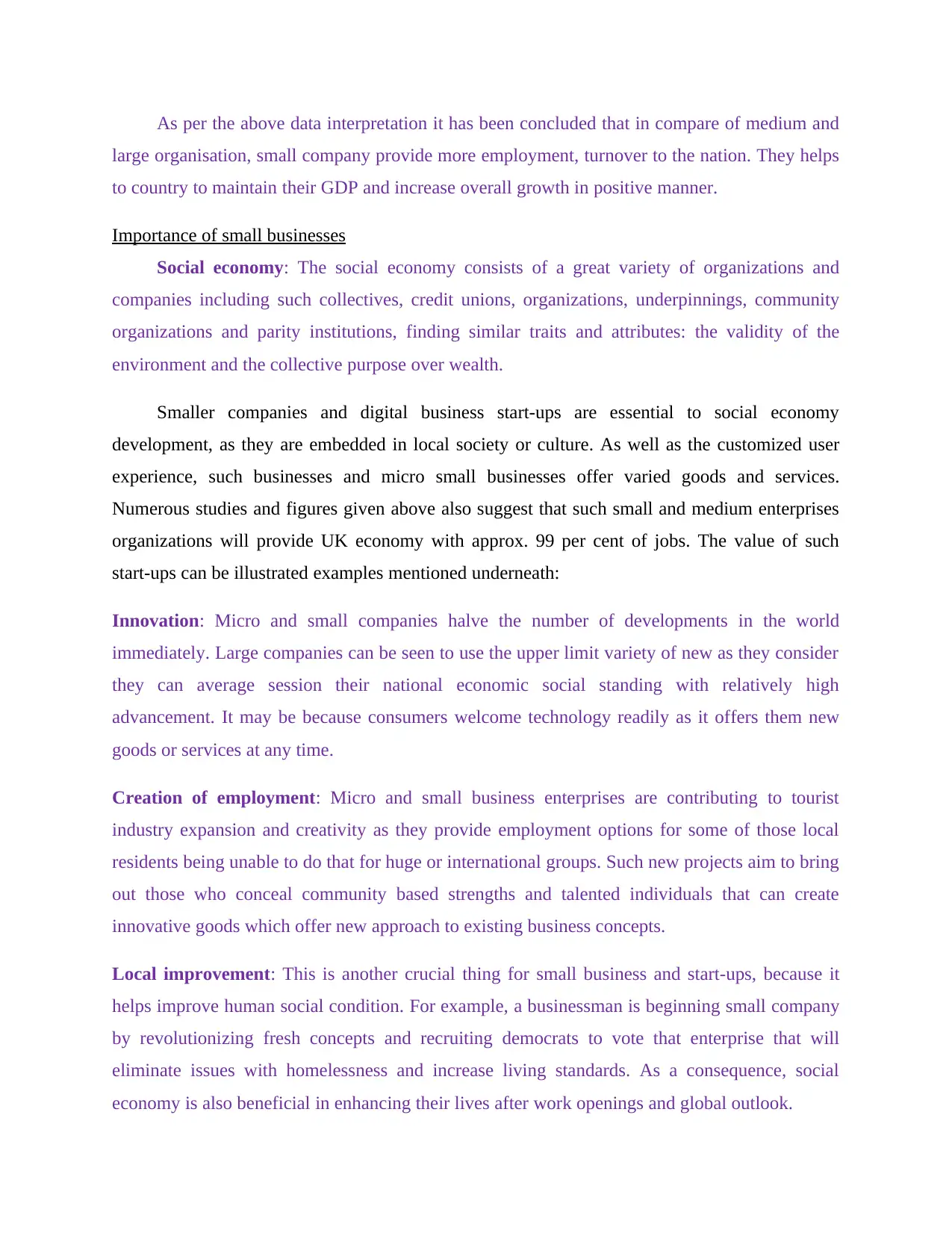
As per the above data interpretation it has been concluded that in compare of medium and
large organisation, small company provide more employment, turnover to the nation. They helps
to country to maintain their GDP and increase overall growth in positive manner.
Importance of small businesses
Social economy: The social economy consists of a great variety of organizations and
companies including such collectives, credit unions, organizations, underpinnings, community
organizations and parity institutions, finding similar traits and attributes: the validity of the
environment and the collective purpose over wealth.
Smaller companies and digital business start-ups are essential to social economy
development, as they are embedded in local society or culture. As well as the customized user
experience, such businesses and micro small businesses offer varied goods and services.
Numerous studies and figures given above also suggest that such small and medium enterprises
organizations will provide UK economy with approx. 99 per cent of jobs. The value of such
start-ups can be illustrated examples mentioned underneath:
Innovation: Micro and small companies halve the number of developments in the world
immediately. Large companies can be seen to use the upper limit variety of new as they consider
they can average session their national economic social standing with relatively high
advancement. It may be because consumers welcome technology readily as it offers them new
goods or services at any time.
Creation of employment: Micro and small business enterprises are contributing to tourist
industry expansion and creativity as they provide employment options for some of those local
residents being unable to do that for huge or international groups. Such new projects aim to bring
out those who conceal community based strengths and talented individuals that can create
innovative goods which offer new approach to existing business concepts.
Local improvement: This is another crucial thing for small business and start-ups, because it
helps improve human social condition. For example, a businessman is beginning small company
by revolutionizing fresh concepts and recruiting democrats to vote that enterprise that will
eliminate issues with homelessness and increase living standards. As a consequence, social
economy is also beneficial in enhancing their lives after work openings and global outlook.
large organisation, small company provide more employment, turnover to the nation. They helps
to country to maintain their GDP and increase overall growth in positive manner.
Importance of small businesses
Social economy: The social economy consists of a great variety of organizations and
companies including such collectives, credit unions, organizations, underpinnings, community
organizations and parity institutions, finding similar traits and attributes: the validity of the
environment and the collective purpose over wealth.
Smaller companies and digital business start-ups are essential to social economy
development, as they are embedded in local society or culture. As well as the customized user
experience, such businesses and micro small businesses offer varied goods and services.
Numerous studies and figures given above also suggest that such small and medium enterprises
organizations will provide UK economy with approx. 99 per cent of jobs. The value of such
start-ups can be illustrated examples mentioned underneath:
Innovation: Micro and small companies halve the number of developments in the world
immediately. Large companies can be seen to use the upper limit variety of new as they consider
they can average session their national economic social standing with relatively high
advancement. It may be because consumers welcome technology readily as it offers them new
goods or services at any time.
Creation of employment: Micro and small business enterprises are contributing to tourist
industry expansion and creativity as they provide employment options for some of those local
residents being unable to do that for huge or international groups. Such new projects aim to bring
out those who conceal community based strengths and talented individuals that can create
innovative goods which offer new approach to existing business concepts.
Local improvement: This is another crucial thing for small business and start-ups, because it
helps improve human social condition. For example, a businessman is beginning small company
by revolutionizing fresh concepts and recruiting democrats to vote that enterprise that will
eliminate issues with homelessness and increase living standards. As a consequence, social
economy is also beneficial in enhancing their lives after work openings and global outlook.
⊘ This is a preview!⊘
Do you want full access?
Subscribe today to unlock all pages.

Trusted by 1+ million students worldwide
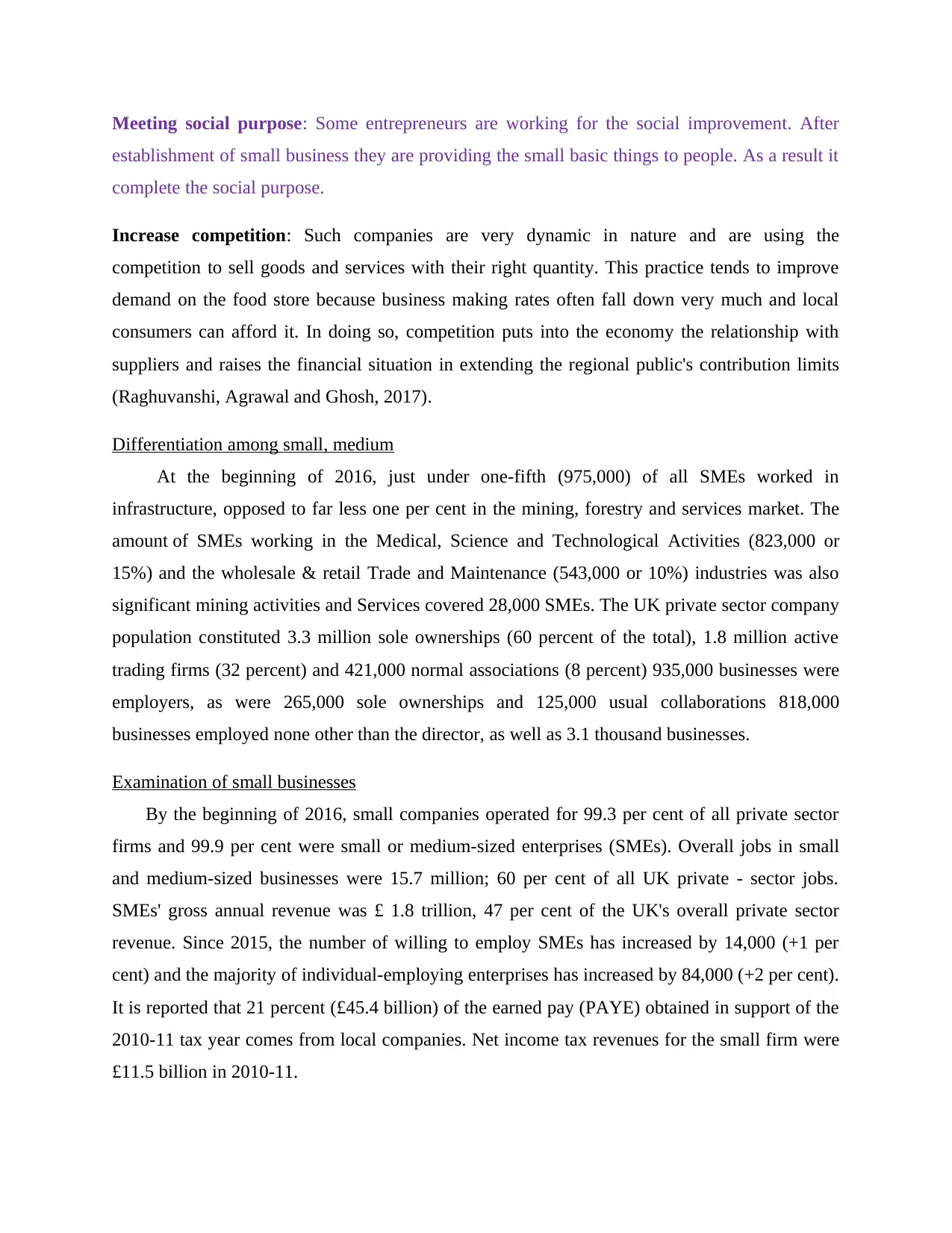
Meeting social purpose: Some entrepreneurs are working for the social improvement. After
establishment of small business they are providing the small basic things to people. As a result it
complete the social purpose.
Increase competition: Such companies are very dynamic in nature and are using the
competition to sell goods and services with their right quantity. This practice tends to improve
demand on the food store because business making rates often fall down very much and local
consumers can afford it. In doing so, competition puts into the economy the relationship with
suppliers and raises the financial situation in extending the regional public's contribution limits
(Raghuvanshi, Agrawal and Ghosh, 2017).
Differentiation among small, medium
At the beginning of 2016, just under one-fifth (975,000) of all SMEs worked in
infrastructure, opposed to far less one per cent in the mining, forestry and services market. The
amount of SMEs working in the Medical, Science and Technological Activities (823,000 or
15%) and the wholesale & retail Trade and Maintenance (543,000 or 10%) industries was also
significant mining activities and Services covered 28,000 SMEs. The UK private sector company
population constituted 3.3 million sole ownerships (60 percent of the total), 1.8 million active
trading firms (32 percent) and 421,000 normal associations (8 percent) 935,000 businesses were
employers, as were 265,000 sole ownerships and 125,000 usual collaborations 818,000
businesses employed none other than the director, as well as 3.1 thousand businesses.
Examination of small businesses
By the beginning of 2016, small companies operated for 99.3 per cent of all private sector
firms and 99.9 per cent were small or medium-sized enterprises (SMEs). Overall jobs in small
and medium-sized businesses were 15.7 million; 60 per cent of all UK private - sector jobs.
SMEs' gross annual revenue was £ 1.8 trillion, 47 per cent of the UK's overall private sector
revenue. Since 2015, the number of willing to employ SMEs has increased by 14,000 (+1 per
cent) and the majority of individual-employing enterprises has increased by 84,000 (+2 per cent).
It is reported that 21 percent (£45.4 billion) of the earned pay (PAYE) obtained in support of the
2010-11 tax year comes from local companies. Net income tax revenues for the small firm were
£11.5 billion in 2010-11.
establishment of small business they are providing the small basic things to people. As a result it
complete the social purpose.
Increase competition: Such companies are very dynamic in nature and are using the
competition to sell goods and services with their right quantity. This practice tends to improve
demand on the food store because business making rates often fall down very much and local
consumers can afford it. In doing so, competition puts into the economy the relationship with
suppliers and raises the financial situation in extending the regional public's contribution limits
(Raghuvanshi, Agrawal and Ghosh, 2017).
Differentiation among small, medium
At the beginning of 2016, just under one-fifth (975,000) of all SMEs worked in
infrastructure, opposed to far less one per cent in the mining, forestry and services market. The
amount of SMEs working in the Medical, Science and Technological Activities (823,000 or
15%) and the wholesale & retail Trade and Maintenance (543,000 or 10%) industries was also
significant mining activities and Services covered 28,000 SMEs. The UK private sector company
population constituted 3.3 million sole ownerships (60 percent of the total), 1.8 million active
trading firms (32 percent) and 421,000 normal associations (8 percent) 935,000 businesses were
employers, as were 265,000 sole ownerships and 125,000 usual collaborations 818,000
businesses employed none other than the director, as well as 3.1 thousand businesses.
Examination of small businesses
By the beginning of 2016, small companies operated for 99.3 per cent of all private sector
firms and 99.9 per cent were small or medium-sized enterprises (SMEs). Overall jobs in small
and medium-sized businesses were 15.7 million; 60 per cent of all UK private - sector jobs.
SMEs' gross annual revenue was £ 1.8 trillion, 47 per cent of the UK's overall private sector
revenue. Since 2015, the number of willing to employ SMEs has increased by 14,000 (+1 per
cent) and the majority of individual-employing enterprises has increased by 84,000 (+2 per cent).
It is reported that 21 percent (£45.4 billion) of the earned pay (PAYE) obtained in support of the
2010-11 tax year comes from local companies. Net income tax revenues for the small firm were
£11.5 billion in 2010-11.
Paraphrase This Document
Need a fresh take? Get an instant paraphrase of this document with our AI Paraphraser
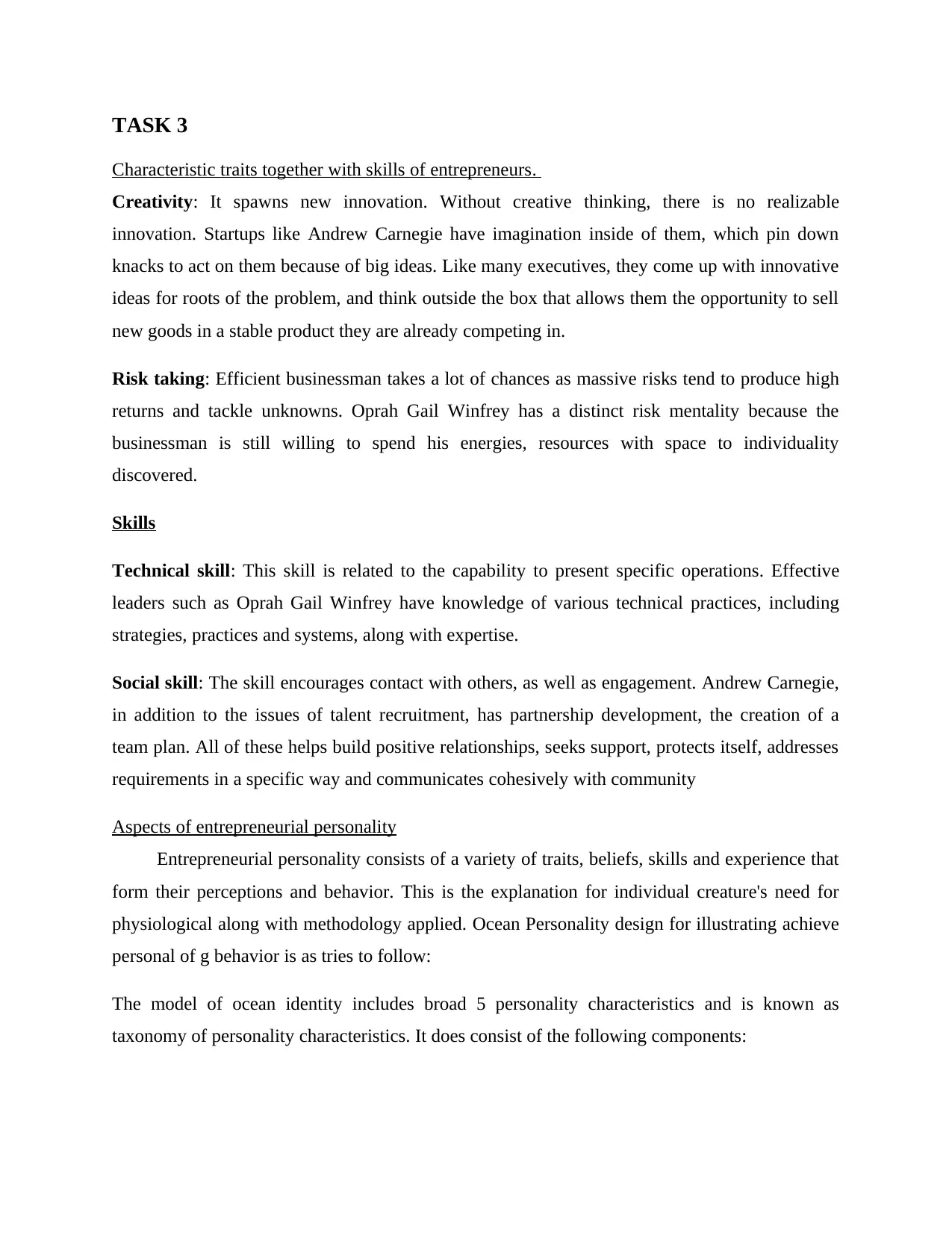
TASK 3
Characteristic traits together with skills of entrepreneurs.
Creativity: It spawns new innovation. Without creative thinking, there is no realizable
innovation. Startups like Andrew Carnegie have imagination inside of them, which pin down
knacks to act on them because of big ideas. Like many executives, they come up with innovative
ideas for roots of the problem, and think outside the box that allows them the opportunity to sell
new goods in a stable product they are already competing in.
Risk taking: Efficient businessman takes a lot of chances as massive risks tend to produce high
returns and tackle unknowns. Oprah Gail Winfrey has a distinct risk mentality because the
businessman is still willing to spend his energies, resources with space to individuality
discovered.
Skills
Technical skill: This skill is related to the capability to present specific operations. Effective
leaders such as Oprah Gail Winfrey have knowledge of various technical practices, including
strategies, practices and systems, along with expertise.
Social skill: The skill encourages contact with others, as well as engagement. Andrew Carnegie,
in addition to the issues of talent recruitment, has partnership development, the creation of a
team plan. All of these helps build positive relationships, seeks support, protects itself, addresses
requirements in a specific way and communicates cohesively with community
Aspects of entrepreneurial personality
Entrepreneurial personality consists of a variety of traits, beliefs, skills and experience that
form their perceptions and behavior. This is the explanation for individual creature's need for
physiological along with methodology applied. Ocean Personality design for illustrating achieve
personal of g behavior is as tries to follow:
The model of ocean identity includes broad 5 personality characteristics and is known as
taxonomy of personality characteristics. It does consist of the following components:
Characteristic traits together with skills of entrepreneurs.
Creativity: It spawns new innovation. Without creative thinking, there is no realizable
innovation. Startups like Andrew Carnegie have imagination inside of them, which pin down
knacks to act on them because of big ideas. Like many executives, they come up with innovative
ideas for roots of the problem, and think outside the box that allows them the opportunity to sell
new goods in a stable product they are already competing in.
Risk taking: Efficient businessman takes a lot of chances as massive risks tend to produce high
returns and tackle unknowns. Oprah Gail Winfrey has a distinct risk mentality because the
businessman is still willing to spend his energies, resources with space to individuality
discovered.
Skills
Technical skill: This skill is related to the capability to present specific operations. Effective
leaders such as Oprah Gail Winfrey have knowledge of various technical practices, including
strategies, practices and systems, along with expertise.
Social skill: The skill encourages contact with others, as well as engagement. Andrew Carnegie,
in addition to the issues of talent recruitment, has partnership development, the creation of a
team plan. All of these helps build positive relationships, seeks support, protects itself, addresses
requirements in a specific way and communicates cohesively with community
Aspects of entrepreneurial personality
Entrepreneurial personality consists of a variety of traits, beliefs, skills and experience that
form their perceptions and behavior. This is the explanation for individual creature's need for
physiological along with methodology applied. Ocean Personality design for illustrating achieve
personal of g behavior is as tries to follow:
The model of ocean identity includes broad 5 personality characteristics and is known as
taxonomy of personality characteristics. It does consist of the following components:
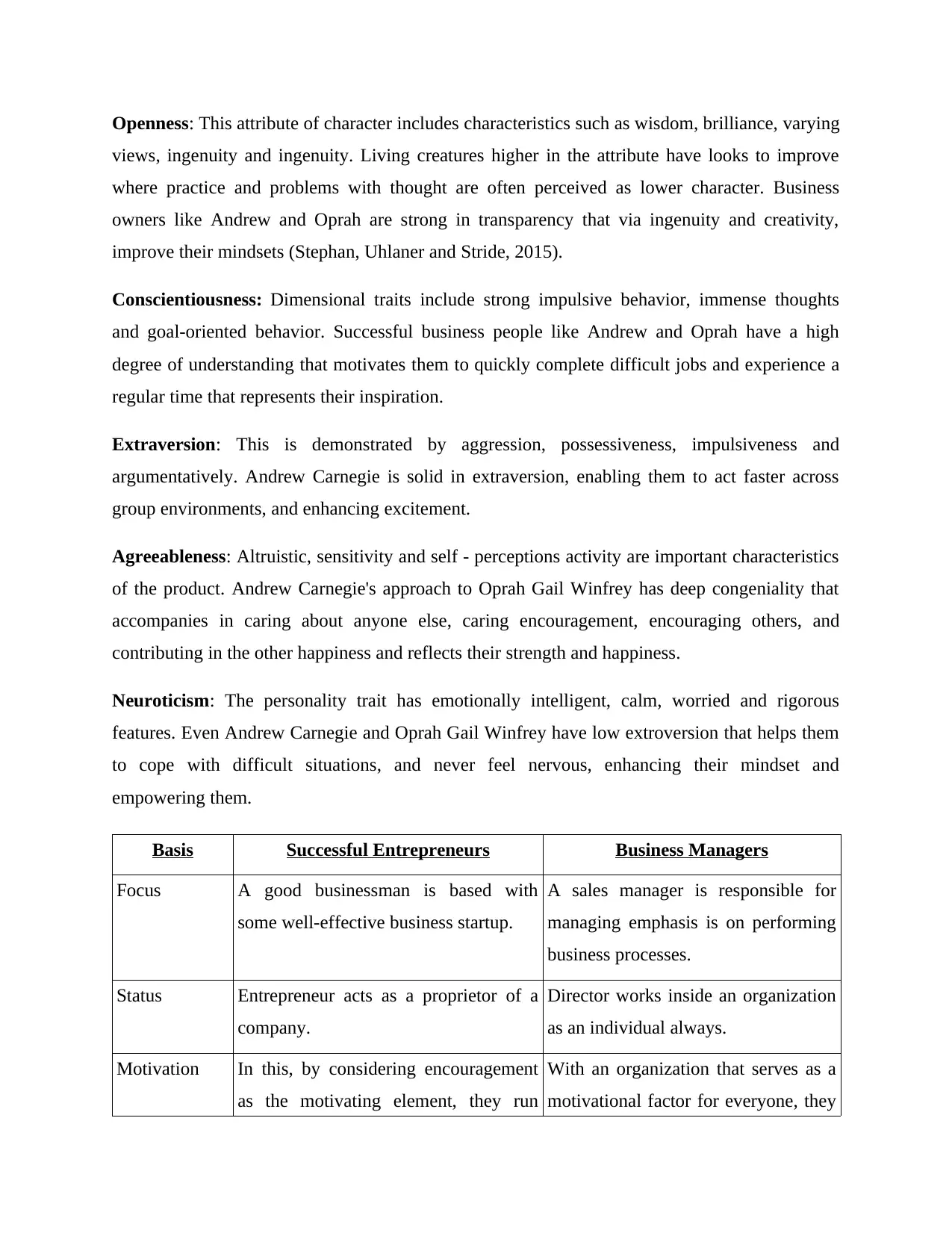
Openness: This attribute of character includes characteristics such as wisdom, brilliance, varying
views, ingenuity and ingenuity. Living creatures higher in the attribute have looks to improve
where practice and problems with thought are often perceived as lower character. Business
owners like Andrew and Oprah are strong in transparency that via ingenuity and creativity,
improve their mindsets (Stephan, Uhlaner and Stride, 2015).
Conscientiousness: Dimensional traits include strong impulsive behavior, immense thoughts
and goal-oriented behavior. Successful business people like Andrew and Oprah have a high
degree of understanding that motivates them to quickly complete difficult jobs and experience a
regular time that represents their inspiration.
Extraversion: This is demonstrated by aggression, possessiveness, impulsiveness and
argumentatively. Andrew Carnegie is solid in extraversion, enabling them to act faster across
group environments, and enhancing excitement.
Agreeableness: Altruistic, sensitivity and self - perceptions activity are important characteristics
of the product. Andrew Carnegie's approach to Oprah Gail Winfrey has deep congeniality that
accompanies in caring about anyone else, caring encouragement, encouraging others, and
contributing in the other happiness and reflects their strength and happiness.
Neuroticism: The personality trait has emotionally intelligent, calm, worried and rigorous
features. Even Andrew Carnegie and Oprah Gail Winfrey have low extroversion that helps them
to cope with difficult situations, and never feel nervous, enhancing their mindset and
empowering them.
Basis Successful Entrepreneurs Business Managers
Focus A good businessman is based with
some well-effective business startup.
A sales manager is responsible for
managing emphasis is on performing
business processes.
Status Entrepreneur acts as a proprietor of a
company.
Director works inside an organization
as an individual always.
Motivation In this, by considering encouragement
as the motivating element, they run
With an organization that serves as a
motivational factor for everyone, they
views, ingenuity and ingenuity. Living creatures higher in the attribute have looks to improve
where practice and problems with thought are often perceived as lower character. Business
owners like Andrew and Oprah are strong in transparency that via ingenuity and creativity,
improve their mindsets (Stephan, Uhlaner and Stride, 2015).
Conscientiousness: Dimensional traits include strong impulsive behavior, immense thoughts
and goal-oriented behavior. Successful business people like Andrew and Oprah have a high
degree of understanding that motivates them to quickly complete difficult jobs and experience a
regular time that represents their inspiration.
Extraversion: This is demonstrated by aggression, possessiveness, impulsiveness and
argumentatively. Andrew Carnegie is solid in extraversion, enabling them to act faster across
group environments, and enhancing excitement.
Agreeableness: Altruistic, sensitivity and self - perceptions activity are important characteristics
of the product. Andrew Carnegie's approach to Oprah Gail Winfrey has deep congeniality that
accompanies in caring about anyone else, caring encouragement, encouraging others, and
contributing in the other happiness and reflects their strength and happiness.
Neuroticism: The personality trait has emotionally intelligent, calm, worried and rigorous
features. Even Andrew Carnegie and Oprah Gail Winfrey have low extroversion that helps them
to cope with difficult situations, and never feel nervous, enhancing their mindset and
empowering them.
Basis Successful Entrepreneurs Business Managers
Focus A good businessman is based with
some well-effective business startup.
A sales manager is responsible for
managing emphasis is on performing
business processes.
Status Entrepreneur acts as a proprietor of a
company.
Director works inside an organization
as an individual always.
Motivation In this, by considering encouragement
as the motivating element, they run
With an organization that serves as a
motivational factor for everyone, they
⊘ This is a preview!⊘
Do you want full access?
Subscribe today to unlock all pages.

Trusted by 1+ million students worldwide
1 out of 18
Related Documents
Your All-in-One AI-Powered Toolkit for Academic Success.
+13062052269
info@desklib.com
Available 24*7 on WhatsApp / Email
![[object Object]](/_next/static/media/star-bottom.7253800d.svg)
Unlock your academic potential
Copyright © 2020–2025 A2Z Services. All Rights Reserved. Developed and managed by ZUCOL.





